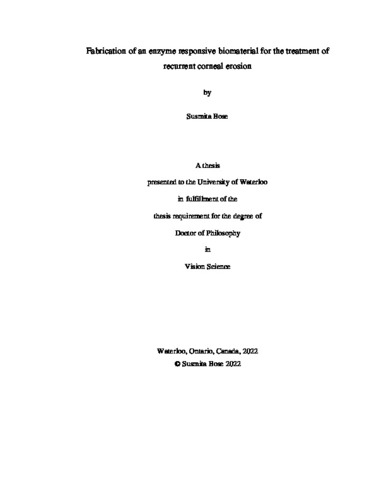| dc.description.abstract | Purpose: Recurrent corneal erosion (RCE) arising from the loss of superficial corneal epithelial cells causes tremendous ocular pain affecting one’s productivity and quality of life. RCE was traditionally treated with eye lubricants and patching (to stop blinking). Soft bandage contact lenses (BCLs), which enable the use of vision during the healing process, have become more widely used in recent years. Because BCLs do not yet contain the therapeutic components necessary for ocular surface repair, they do not outperform ocular lubricants in terms of effectiveness or recovery time. This is a problem. Multiple studies have shown elevated levels of matrix metalloproteinase (MMP) enzymes, particularly MMP-9 and MMP-2, in RCE. The purpose of this thesis was to develop an enzyme-triggered therapeutic release platform using a unique gelatin methacrylate formulation (GelMA+) and bovine lactoferrin (BLF), a potential corneal wound healing therapeutic.
Method: Two different formulations of GelMA+ gels were synthesized: 20% w/v and 30% w/v GelMA+ gels. To determine the effect of polymer concentration on the physical characteristics and cytotoxicity of the gels, physical characterization, including mechanical strength, swelling behaviour, pore size, optical clarity, degradation profile in the enzyme MMP-9 and MMP-8, were evaluated. To evaluate whether GelMA+ is suitable to be a biomaterial, cytotoxicity assays (alamarBlue and live/dead assay) were performed on both the GelMA+ formulations. These physical and biological characterization of GelMA+ gels helped to choose the specific GelMA+ formulation for studying the in vitro release profile of BLF from the GelMA+ matrix. To assess the efficacy and therapeutic window of BLF for corneal epithelial cells wound healing, a scratch induced assay model was used.
Results: GelMA showed a tunable profile suitable for the diffusion- and enzyme-mediated controlled release of therapeutics above the molecular weight region of 70 kDa. Owing to the high polymer concentration as opposed to 20% w/v GelMA+, the 30% w/v GelMA+ had a higher crosslinking density, tensile strength, smaller pore size, and lower swelling ratio than the 20% w/v GelMA+ (p<0.05). The degradation rate of the 20% w/v gel was much faster (p<0.001), degrading almost completely after 48 hours at 300 µg/mL of MMP-9 whereas 30% w/v GelMA+ gels took almost 6 days to achieve around 95% degradation in the same MMP-9 concentration. After 5 days, no cytotoxicity was detected in the live/dead staining for either formulation, but the 30% w/v GelMA+ showed significantly higher cell viability (p<0.05). In the BLF release study, no burst release of BLF was observed for the 30% w/v gel, and the therapeutic release was sustained over 5 days. The rate of release from the gel significantly increased with increasing concentrations of MMP-9 (p<0.001) and correlated to the rate of degradation of the gels. BLF at 10 mg/mL induced complete wound closure in four days, and 7.5 mg/mL completely closed the wound in six days, suggesting that BLF might be an excellent therapeutic option for corneal abnormalities brought on by mechanical injury. A concentration of 7.5mg/mL or 10 mg/mL BLF would be an appropriate therapeutic window to be released from 30% w/v GelMA+ for treating RCE within a week.
Conclusion: The results showed that the degradation of GelMA+ can be tuned by modifying the crosslinking density or exposure to different concentrations of MMP-9. The release of BLF from 30% w/v GelMA+ is driven by a combination of diffusion and degradation of the material by MMP-9 enzymes. Hence the therapeutic releasing enzyme responsive GelMA+ as a BCL can be potential future treatment for RCE. Future work will focus on optimizing the materials to deliver other therapeutic agents at physiologically relevant concentrations of MMP enzymes found in the tear fluid. | en |

